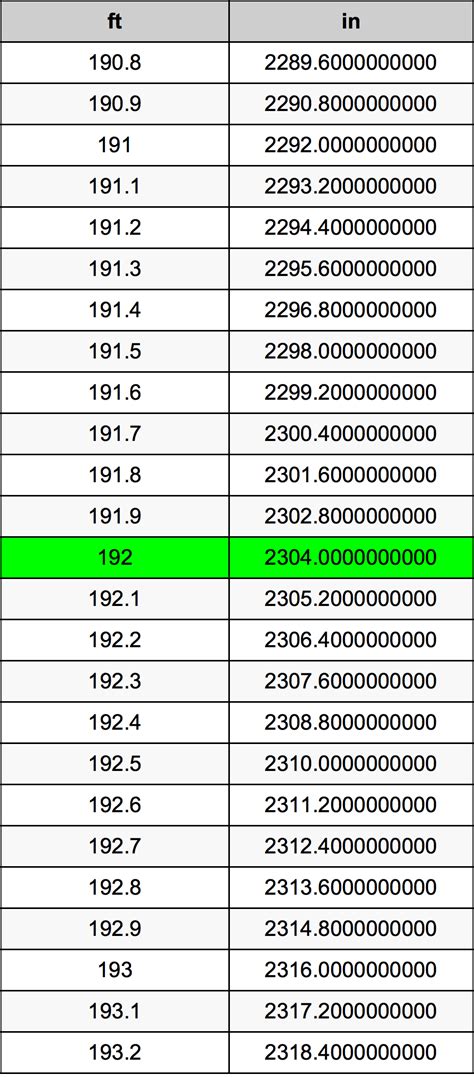How Many Feet Are In 192 Inches
Kalali
Apr 05, 2025 · 4 min read

Table of Contents
How Many Feet Are in 192 Inches? A Comprehensive Guide to Unit Conversions
Knowing how to convert between different units of measurement is a fundamental skill with applications across numerous fields, from everyday life to complex engineering projects. This comprehensive guide will delve into the simple yet crucial conversion of inches to feet, focusing specifically on the question: how many feet are in 192 inches? We'll explore the method, provide practical examples, and discuss related conversions to solidify your understanding.
Understanding the Basic Relationship Between Inches and Feet
Before we tackle the specific conversion of 192 inches, it's essential to establish the foundational relationship between inches and feet within the imperial system of measurement. The imperial system, also known as the US customary system, uses inches, feet, yards, and miles to measure length. The key relationship to remember for this conversion is:
1 foot = 12 inches
This means that one foot is comprised of twelve individual inches. This simple equivalence is the cornerstone of all inch-to-foot conversions.
Calculating Feet from Inches: The Simple Formula
Converting inches to feet involves a straightforward division. Since there are 12 inches in every foot, we simply divide the total number of inches by 12 to find the equivalent number of feet. The formula can be expressed as:
Feet = Inches / 12
Let's apply this formula to answer our primary question: how many feet are in 192 inches?
Solving the Problem: 192 Inches to Feet
Using the formula above, we can readily determine the number of feet in 192 inches:
Feet = 192 inches / 12 inches/foot = 16 feet
Therefore, there are 16 feet in 192 inches.
Real-World Applications and Examples
Understanding inch-to-foot conversions has numerous practical applications in various scenarios:
-
Construction and Home Improvement: Builders, carpenters, and DIY enthusiasts regularly use these conversions when planning projects, cutting materials, and measuring distances. Knowing that 192 inches equals 16 feet is crucial for tasks like calculating the length of a fence, the dimensions of a room, or the amount of lumber needed for a project.
-
Engineering and Design: Engineers and designers often work with blueprints and technical drawings that use inches and feet. Accurate conversions are essential for ensuring the precision and functionality of their designs, from building bridges to designing furniture.
-
Fabric and Sewing: In the textile industry, fabric measurements are commonly given in inches. Converting these measurements to feet is necessary for tasks such as cutting patterns, calculating fabric yardage, and ensuring accurate garment sizing.
-
Everyday Measurements: Even in everyday life, understanding inch-to-foot conversions can be useful. For example, when measuring the height of a child, understanding the conversion from inches to feet can provide a clearer picture of their growth.
Expanding the Understanding: Beyond 192 Inches
While we've focused on 192 inches, let's explore a few more examples to solidify your understanding of inch-to-foot conversions:
-
How many feet are in 36 inches? Following the formula: 36 inches / 12 inches/foot = 3 feet.
-
How many feet are in 288 inches? Following the formula: 288 inches / 12 inches/foot = 24 feet.
-
How many feet are in 72 inches? Following the formula: 72 inches / 12 inches/foot = 6 feet.
These examples illustrate the versatility and simplicity of the conversion formula.
Converting Feet to Inches: The Reverse Calculation
It's equally important to understand the reverse conversion – converting feet back into inches. To do this, simply multiply the number of feet by 12. The formula is:
Inches = Feet * 12
For example, to convert 10 feet to inches:
Inches = 10 feet * 12 inches/foot = 120 inches
Advanced Conversions: Involving Yards and Miles
The imperial system also incorporates yards and miles. Knowing the relationship between these units can be helpful for more complex conversions. Remember:
- 1 yard = 3 feet = 36 inches
- 1 mile = 5280 feet = 63,360 inches
By understanding these relationships, you can perform more extensive conversions. For instance, to convert 192 inches to yards, you would first convert inches to feet (16 feet), then divide by 3 (16 feet / 3 feet/yard = 5.33 yards).
Troubleshooting Common Conversion Errors
While inch-to-foot conversions are relatively straightforward, some common errors can occur:
-
Incorrect Formula: Ensuring you're using the correct formula (division for inches to feet, multiplication for feet to inches) is crucial.
-
Misplaced Decimal Points: Carefully handling decimal points during calculations is essential for accuracy.
-
Unit Confusion: Always double-check the units you're working with to avoid errors.
Conclusion: Mastering Inch-to-Foot Conversions
Mastering the conversion between inches and feet is a valuable skill with wide-ranging applications. By understanding the basic relationship of 12 inches per foot and applying the simple formulas provided, you can confidently tackle a variety of measurement conversion tasks. Remember to practice regularly and double-check your work to ensure accuracy. The ability to perform these conversions smoothly will not only improve your problem-solving abilities but will also prove invaluable in numerous professional and personal endeavors. From home improvements to engineering projects, this fundamental skill enhances efficiency and accuracy in various contexts.
Latest Posts
Latest Posts
-
How Many Centimeters Is 48 Inches
Apr 06, 2025
-
How Many Centimeters Are In 8 5 Inches
Apr 06, 2025
-
How Much Is 24 Oz Of Water
Apr 06, 2025
-
What Is A 36 Out Of 40
Apr 06, 2025
-
In What Cell Organelle Does Cellular Respiration Take Place
Apr 06, 2025
Related Post
Thank you for visiting our website which covers about How Many Feet Are In 192 Inches . We hope the information provided has been useful to you. Feel free to contact us if you have any questions or need further assistance. See you next time and don't miss to bookmark.
